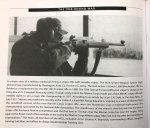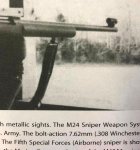I have a question about how to install the OK Weber front sight base for the globe sight on a M24 rifle.
After studying numerous pictures on the M24 front sight base, (most pictures don't have the globe front sight mounted), I've notice Remington mount the front sight base with the notch to the left, that means when the globe sight installed, the screw-on cap will be facing the front. I think typically, the front globe sight on target rifle, the globe sight screw-on cap should be facing the rear. Keep in mind that some globe sight will have a magnifier. So which way is the correct way to install the front sight base? The notch should be on the left, or right? The screw on cap facing the front or rear?
After studying numerous pictures on the M24 front sight base, (most pictures don't have the globe front sight mounted), I've notice Remington mount the front sight base with the notch to the left, that means when the globe sight installed, the screw-on cap will be facing the front. I think typically, the front globe sight on target rifle, the globe sight screw-on cap should be facing the rear. Keep in mind that some globe sight will have a magnifier. So which way is the correct way to install the front sight base? The notch should be on the left, or right? The screw on cap facing the front or rear?






